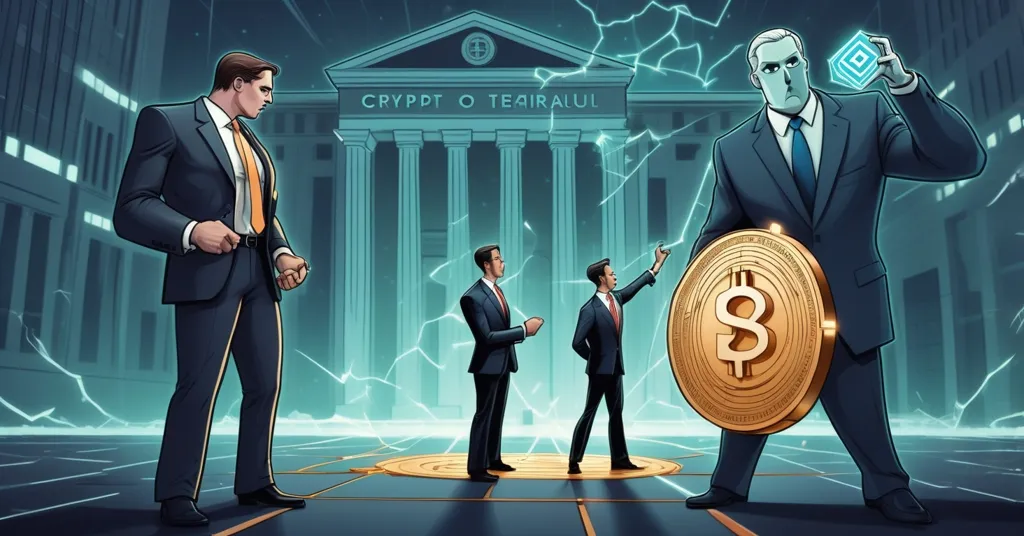Bankers Push Treasury for Stablecoin Interest Ban Under GENIUS Act, Sparking Crypto Clash

Bankers Demand Stablecoin Interest Ban: ABA Pushes Treasury on GENIUS Act Enforcement
The American Bankers Association (ABA), backed by 52 state bankers associations, has fired a shot across the bow of the crypto world, urging the U.S. Department of the Treasury to enforce the GENIUS Act’s ban on interest or yield for payment stablecoins. Their fear? Digital dollars offering juicy returns could suck billions out of traditional banks, threatening financial stability and gutting community lending. Meanwhile, this clash is stalling critical crypto legislation, leaving the U.S. at a crossroads between innovation and systemic risk.
- ABA and 52 state associations demand strict enforcement of GENIUS Act’s stablecoin interest ban.
- Interest-bearing stablecoins could drain $1.5 trillion in lending capacity from banks.
- Community banks in rural areas risk massive credit losses for small businesses and farms.
- Stablecoin debate delays pivotal Market Structure Bill, stoking crypto-banking tensions.
- Global leadership in blockchain hangs in balance as U.S. policy lags behind competitors.
The Banking Panic: A System Under Siege
For those new to the crypto game, stablecoins are digital currencies pegged to stable assets like the U.S. dollar, designed to avoid the wild price swings of Bitcoin or Ethereum. They’re like digital cash—perfect for payments or cross-border transfers. Payment stablecoins, in particular, are intended as transactional tools, not piggy banks or investment schemes. But if issuers start offering interest or yields, they could become direct competitors to bank savings accounts. That’s the crux of the GENIUS Act, a legislative measure aimed at keeping stablecoins in check by banning any form of economic benefit, whether it’s direct interest or sneaky perks through affiliate partnerships. The ABA’s recent letter to the Treasury, as detailed in a report on the push for enforcement, isn’t a casual suggestion—it’s a battle cry to plug every possible loophole before stablecoin issuers turn this tech into a banking wrecking ball.
The numbers the ABA throws out are enough to make any banker sweat. They estimate that interest-bearing stablecoins could trigger deposit outflows—think of it as money draining from bank accounts like water from a leaky dam—of up to 25.9%. That translates to a staggering $1.5 trillion loss in lending capacity, based on their internal modeling. This isn’t just a problem for Wall Street giants; it’s a death knell for community banks, especially in rural and underserved areas where they’re often the only financial lifeline. The ABA projects small business credit could shrink by $110 billion, while farm credit might take a $62 billion hit. Picture a family farm in Iowa, already struggling with tight margins, suddenly unable to secure a loan for next season’s crop because their local bank’s deposits have vanished into some shiny stablecoin app promising 5% returns. These stats aren’t just cold data—they’re the potential unraveling of local economies across the country.
Let’s be real: the banking lobby is in full-on panic mode, and they’ve got a point. Stablecoins like USDT and USDC already command a combined market cap north of $150 billion without widespread yield offerings. If issuers dangle returns that banks can’t match—especially in today’s low-interest climate—the exodus could be catastrophic. Community banks, lacking the tech or scale of big players, would be the first to fold. The ABA’s plea to the Treasury is blunt: define “interest or yield” as broadly as possible, covering any economic carrot, or watch the traditional banking system bleed dry.
Stablecoin Utility and Risks: A Double-Edged Sword
From the crypto side, stablecoins are a game-changer, especially in niches Bitcoin doesn’t touch. They’re the on-ramp for newbies scared of BTC’s volatility and the backbone of decentralized finance (DeFi)—think of DeFi as apps on blockchains like Ethereum that offer financial services like lending or earning interest without a bank middleman. Stablecoin yields, offered through platforms like Aave or Compound, can hit double digits, making them a magnet for users tired of near-zero bank rates. Why park your money in a savings account earning 0.5% when you can stake USDC in a DeFi protocol for 10%? For crypto advocates, banning these yields isn’t just stifling innovation—it’s kneecapping competition and pushing users to less-regulated offshore platforms.
But let’s not pretend this is all rainbows and lambos. Stablecoin yields come with ugly risks, and history has receipts. Look at the Terra/Luna collapse in 2022—an algorithmic stablecoin promising sky-high yields imploded, wiping out $40 billion in value overnight and torching retail investors. The issue? Over-leveraged promises and opaque reserves. If interest-bearing stablecoins follow the same playbook, offering unsustainable returns without transparent backing, we’re flirting with a crisis that could dwarf Terra. Bitcoin, by contrast, doesn’t play these games—it’s a trustless asset with no yield gimmicks, just pure decentralization. Stablecoins, often centralized and tethered to fiat systems, risk becoming the new middlemen we’re trying to ditch, especially if yields enrich issuers while leaving users holding the bag during a crash.
Legislative Stalemate: Crypto vs. Banking Showdown
Zoom out to Capitol Hill, and the stablecoin fight is clogging up a much bigger machine. The Market Structure Bill, dubbed by Senator Cynthia Lummis as the “most important piece of digital asset legislation in United States history,” is stuck in neutral. This isn’t just about stablecoin regulation; it’s a sweeping framework tackling everything from exchange licensing to custody rules for cryptocurrencies. It’s the kind of legislation that could cement the U.S. as the global hub for blockchain innovation. Yet, the rift over stablecoin interest provisions has ground progress to a halt. Senate Banking Republicans, led by Chairman Tim Scott, missed their end-of-September target to advance the bill, caught in a tug-of-war with crypto lobbies pushing for leniency and banking groups demanding ironclad bans.
“Congress has a unique opportunity to position the United States as a leader in the global crypto industry, achievable only through effective market structure legislation,” said Mason Lynaugh, community director for Stand with Crypto.
Lynaugh’s frustration is palpable, and crypto advocates aren’t wrong to push for speed. But there’s no ignoring the other side. Crypto-friendly Senate Democrats tried to reinforce the interest ban with amendments, only to get shot down by both Republicans and the crypto industry. Can the U.S. afford to keep kicking this can down the road? Every delay widens the gap between innovation and regulation, leaving both sectors in limbo.
Global Stakes: A Race Against Time
This isn’t just a domestic spat—it’s a geopolitical chess match. While the U.S. bickers, competitors are moving fast. China’s rolling out its digital yuan, already in trials across major cities, aiming to dominate digital currency infrastructure. The European Union’s Markets in Crypto-Assets (MiCA) regulation, set to fully launch in 2024, offers a clearer framework for stablecoins and crypto markets than anything the U.S. has on the table. If the Market Structure Bill keeps stalling, America risks losing talent, capital, and influence to jurisdictions eager to onboard the next wave of blockchain adopters. But rush the rules without addressing banking concerns, and you’re rolling the dice on a financial system that, for all its flaws, still props up the global economy. It’s a brutal balancing act—overregulate and kill innovation, underregulate and invite chaos.
Our Take as Decentralization Advocates
As Bitcoin maximalists at heart, we’re skeptical of stablecoins’ centralized nature. They’re tools, not the revolution—often tied to the fiat systems Bitcoin was built to escape. Yet, we can’t deny their utility. Stablecoins grease the wheels for instant cross-border payments and act as safe harbors for crypto newbies. Ethereum and other blockchains hosting DeFi also carve out niches Bitcoin shouldn’t or can’t fill, driving experimentation that fuels this financial uprising. Still, the ABA’s warnings hit hard. If stablecoin yields gut community banks, we’re not disrupting the status quo—we’re just swapping old gatekeepers for new ones with slicker apps. Decentralization isn’t about screwing over rural economies to pad stablecoin issuers’ wallets.
We champion effective accelerationism (e/acc)—pushing tech forward with purpose, not blind chaos. How do we balance this? Maybe cap stablecoin yields or tie them to transparent, audited reserves to avoid Terra-style disasters. And let’s not forget privacy—strict regulation could mean more KYC (Know Your Customer) hoops, stripping away the anonymity crypto promises. Financial freedom and disruption are our north stars, but they don’t mean torching the little guy. Bitcoin remains the gold standard for trustless value; stablecoins and DeFi must prove they’re not just printing lambos for issuers while banks—and users—get rekt.
Key Takeaways and Questions
- What is the GENIUS Act, and why ban stablecoin interest?
It’s a U.S. law restricting payment stablecoins to transactional use, banning yields to stop them from competing with bank deposits and risking financial stability. - How could stablecoin yields impact community banks?
They risk deposit outflows up to 25.9%, slashing lending by $1.5 trillion and cutting small business and farm credit by $110 billion and $62 billion, respectively. - Why is the Market Structure Bill a big deal for crypto?
It’s a landmark framework for regulating digital assets, vital for U.S. leadership in blockchain, but stablecoin debates are delaying its passage. - Are stablecoin yields a win or a danger for decentralization?
They’re a mixed bag—driving adoption and competition but risking centralization with issuers and systemic crashes if unregulated, as seen with Terra/Luna. - What’s the global cost of U.S. delays in crypto policy?
Stalling cedes ground to rivals like China and the EU, while hasty rules without banking safeguards could destabilize the economy—balance is everything.
The Treasury faces a hell of a choice: clamp down on stablecoin yields and alienate the crypto crowd, or ease up and watch banks hemorrhage. The Market Structure Bill’s gridlock screams that innovation and regulation are rarely pals. We’re all about smashing the status quo at Let’s Talk, Bitcoin, but let’s not kid ourselves—stablecoins aren’t flawless freedom fighters. They’re tech with potential, and if they’re twisted to trash local economies or prop up scammy yield farms, we’ve botched the mission. The fight for a decentralized future isn’t just about blockchain; it’s about dodging the old guard’s sins while building something better. Accelerate, sure, but don’t crash the damn ship.



